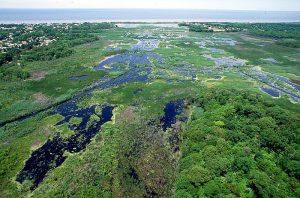
Wetlands in Cape May, New Jersey, USA. View of Fishing Creek Marsh with Miami Beach, New Jersey on the left. from U.S. Army Corps of Engineers Digital Visual Library
Wetlands
When we write faraway magical places, cultures, and creatures we are inspired by the real world. Nothing you could make up is half as weird as Mother Nature already has. If you plan to make any environment a part of your storytelling, you could do worse than go watch a couple of nature documentaries. Look what nature does, and then fantasy-fy it a little. All the creatures in the Sivatag Desert or the Floating City are inspired by real creatures, even if those inspirations are taken in unusual and fantastical directions.
That’s what you get for having a biologist on the team, who asks questions like “what are the nesting habits of kraken?” or “what are the evolutionary environmental pressures of sleeping on gold?”
Where the adventure is set matters. How you get there is part of the story.
So today, to get to the Next Place, your party have to travel through a swamp. Apart from getting their boots wet, what kind of effects does this have on your adventure? Why not just avoid describing the landscape?
Because yet another forest is boring. Because investigating a different ecosystem at the very least provides for different monsters to fight. Because just getting from A to B becomes a challenge – a reason to have the Survival skill, a reason to hire a native guide. Because the real world is diverse and beautiful and bizarre, and therefore the fantasy worlds we build really should be even more so.
Features Continue reading →

